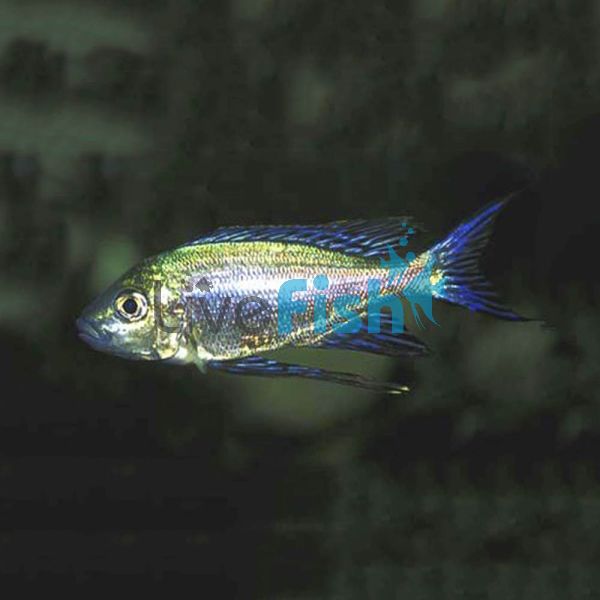Cyathopharynx Furcifer 3cm
Also known as the feather fin cichlid, these fish look very similar to marine fish like anthias. They have a long oval body with abnormal long pelvic and elongated tail fins. Cyathopharynx furcifer as juveniles tend to have a silver body colour with hints of blue scales however as these fish age, especially in males, the colours look almost alien. They have a striking neon blue that runs from head to tail and a jet-black nape across the top of the body. In their breeding colors, this species would be a true spectacle to see and would arguably be unparalleled in the aquarium hobby.
Cyathopharynx Furcifer
Lake Tanganyikan cichlids seem to have their very own dedicated fan following that targets aquarists aver unique and interesting fish. One of these fish is the Cyathopharynx furcifer, an energetic, metallic, and almost marine aquarium-looking species. Reaching around 21 cm long this reasonably large growing cichlid is often found in large groups in the wild where they inhabit areas where large sand bets meet with rock faces. In the home aquarium, they make for an amazing fish to keep in a species-only setting or a Tanganyikan biotope.
Also known as the feather fin cichlid, these fish look very similar to marine fish like anthias. They have a long oval body with abnormal long pelvic and elongated tail fins. Cyathopharynx furcifer as juveniles tend to have a silver body colour with hints of blue scales however as these fish age, especially in males, the colours look almost alien. They have a striking neon blue that runs from head to tail and a jet-black nape across the top of the body. In their breeding colors, this species would be a true spectacle to see and would arguably be unparalleled in the aquarium hobby.
Breeding these fish is possible and a very interesting behavior to observe in the aquarium. Males are known to create a large pit in the substrate to attract females over. The females then deposit eggs into the nest to then scoop up in their mouth which is when the male fertilizes them. Once the eggs hatch and reach a free-swimming stage the female will spit them into a safe location from which the fry can be removed and grown out in another system.
Tank Recommendations for your Cyanthopharynx Furcifer
Cyathopharynx furcifer do get fairly large at around 21 cm which is why the bare minimum aquarium would be around 680 liters. A volume this large is also required to accommodate multiple Furcifer cichlids and to have ample space for their active nature. These are however territorial fish so it is best to ensure there are visual breaks and space for each fish. Providing an open, sandy substrate with rockwork near the back of the aquarium would replicate their wild habitat best. including the use of caves or hiding places will also help ease territorial behavior. These are also tropical fish that are best kept at 24-26 degrees.
Suitable Tank Buddies
The Cyathopharynx furcifer is a territorial species that is often kept in a species-only harem setting which means there are multiple females to a single male in the aquarium. They can however be kept with another lake Tanganyikan fish with caution.
Usually Compatible
Altolamprologus species, synodontis catfish, lepidiolamprologus annateus, and similar medium-growing Tanganyikan species.
Sometimes Compatible
Mbuna and smaller peacock cichlids however this should be avoided.
Rarely Compatible
NonAfrican cichlid species and anything which can be easy prey or predate on the Cyathopharynx furcifer cichlid.
| Scientific Name | Cyathopharynx furcifer |
|---|---|
| Care Level | Moderate |
| Common Names | Feather fin cichlid, furcifer cichlid |
| Diet | Omnivore |
| Fish Family | Cichlidae |
| Lifespan (years) | 6 |
| Max. Length (cm) | 21 |
| Min. Tank Volume (l) | 680 Liters |
| Origin | Africa |
| Reef Safe | No |
| Sociability | Semi-aggressive |
| Venomous | No |
| Water Conditions | 24-26° C, pH 8.0-8.5 |




